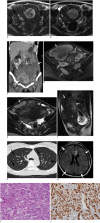CT and MR imaging findings of lymphangioleiomyomatosis involving the uterus and pelvic cavity
- PMID: 21430946
- PMCID: PMC3052620
- DOI: 10.3348/kjr.2011.12.2.261
CT and MR imaging findings of lymphangioleiomyomatosis involving the uterus and pelvic cavity
Abstract
Lymphangioleiomyomatosis (LAM) is a rare idiopathic disease and this is characterized by a proliferation of abnormal smooth muscle cells in the lungs and in the lymphatic system of the thorax and retroperitoneum. The female genital tract is rarely affected by LAM. We report here on the CT and MR imaging findings of extensive LAM involving the uterus and pelvic cavity, and this was seen as multiple cystic uterine and parauterine masses with internal hemorrhage in a young female with tuberous sclerosis complex.
Keywords: Computed tomography (CT); Lymphangioleiomyomatosis; Magnetic resonance (MR); Tuberous sclerosis complex; Uterus.
Figures

Similar articles
-
Extrapulmonary uterine lymphangioleiomyomatosis (LAM) and dysfunctional uterine bleeding: the first presentation of LAM in a tuberous sclerosis complex patient.BMJ Case Rep. 2019 Feb 25;12(2):e226358. doi: 10.1136/bcr-2018-226358. BMJ Case Rep. 2019. PMID: 30804158 Free PMC article.
-
Prevalence of uterine leiomyomas in lymphangioleiomyomatosis.Fertil Steril. 2011 Sep;96(3):711-714.e1. doi: 10.1016/j.fertnstert.2011.06.038. Fertil Steril. 2011. PMID: 21880281 Free PMC article.
-
Malignant presentation of uterine lymphangioleiomyomatosis.Taiwan J Obstet Gynecol. 2015 Oct;54(5):603-7. doi: 10.1016/j.tjog.2015.08.015. Taiwan J Obstet Gynecol. 2015. PMID: 26522119
-
[Lymphangioleiomyomatosis].Zentralbl Chir. 2013 Oct;138 Suppl 1:S59-74; quiz 75-6. doi: 10.1055/s-0033-1346686. Epub 2013 Nov 25. Zentralbl Chir. 2013. PMID: 24277558 Review. German.
-
[Sporadic Lymphangioleiomyomatosis (sLAM) and Tuberous Sclerosis Complex (TSC) - Pulmonary Manifestations].Pneumologie. 2017 Feb;71(2):86-95. doi: 10.1055/s-0042-111522. Epub 2016 Sep 1. Pneumologie. 2017. PMID: 27585353 Review. German.
Cited by
-
Sporadic uterine Lymphangioleiomyomatosis (LAM): Report of a unique case arising in the lower uterine segment with short review.Gynecol Oncol Rep. 2021 Jun 17;37:100812. doi: 10.1016/j.gore.2021.100812. eCollection 2021 Aug. Gynecol Oncol Rep. 2021. PMID: 34195331 Free PMC article.
-
Uterine lymphangioleiomyomatosis in a premenopausal woman with tuberous sclerosis: A case report.Case Rep Womens Health. 2024 Sep 12;43:e00650. doi: 10.1016/j.crwh.2024.e00650. eCollection 2024 Oct. Case Rep Womens Health. 2024. PMID: 39314985 Free PMC article.
-
Uterine PEComas: A Morphologic, Immunohistochemical, and Molecular Analysis of 32 Tumors.Am J Surg Pathol. 2018 Oct;42(10):1370-1383. doi: 10.1097/PAS.0000000000001119. Am J Surg Pathol. 2018. PMID: 30001237 Free PMC article.
References
-
- Longacre TA, Hendrickson MR, Kapp DS, Teng NN. Lymphangioleiomyomatosis of the uterus simulating high-stage endometrial stromal sarcoma. Gynecol Oncol. 1996;63:404–410. - PubMed
-
- Torres VE, Bjornsson J, King BF, Kumar R, Zincke H, Edell ES, et al. Extrapulmonary lymphangioleiomyomatosis and lymphangiomatous cysts in tuberous sclerosis complex. Mayo Clin Proc. 1995;70:641–648. - PubMed
-
- Gyure KA, Hart WR, Kennedy AW. Lymphangiomyomatosis of the uterus associated with tuberous sclerosis and malignant neoplasia of the female genital tract: a report of two cases. Int J Gynecol Pathol. 1995;14:344–351. - PubMed

